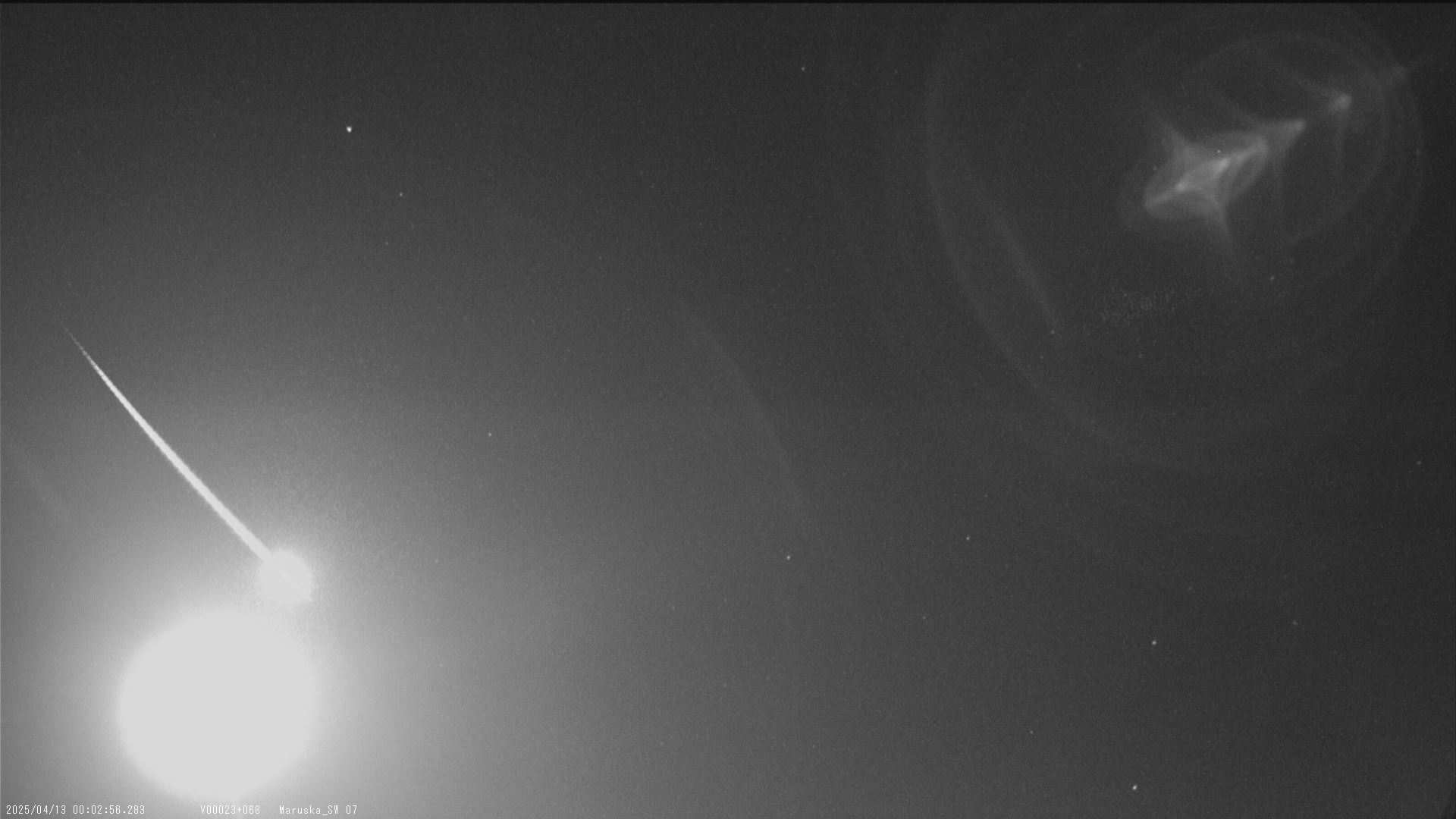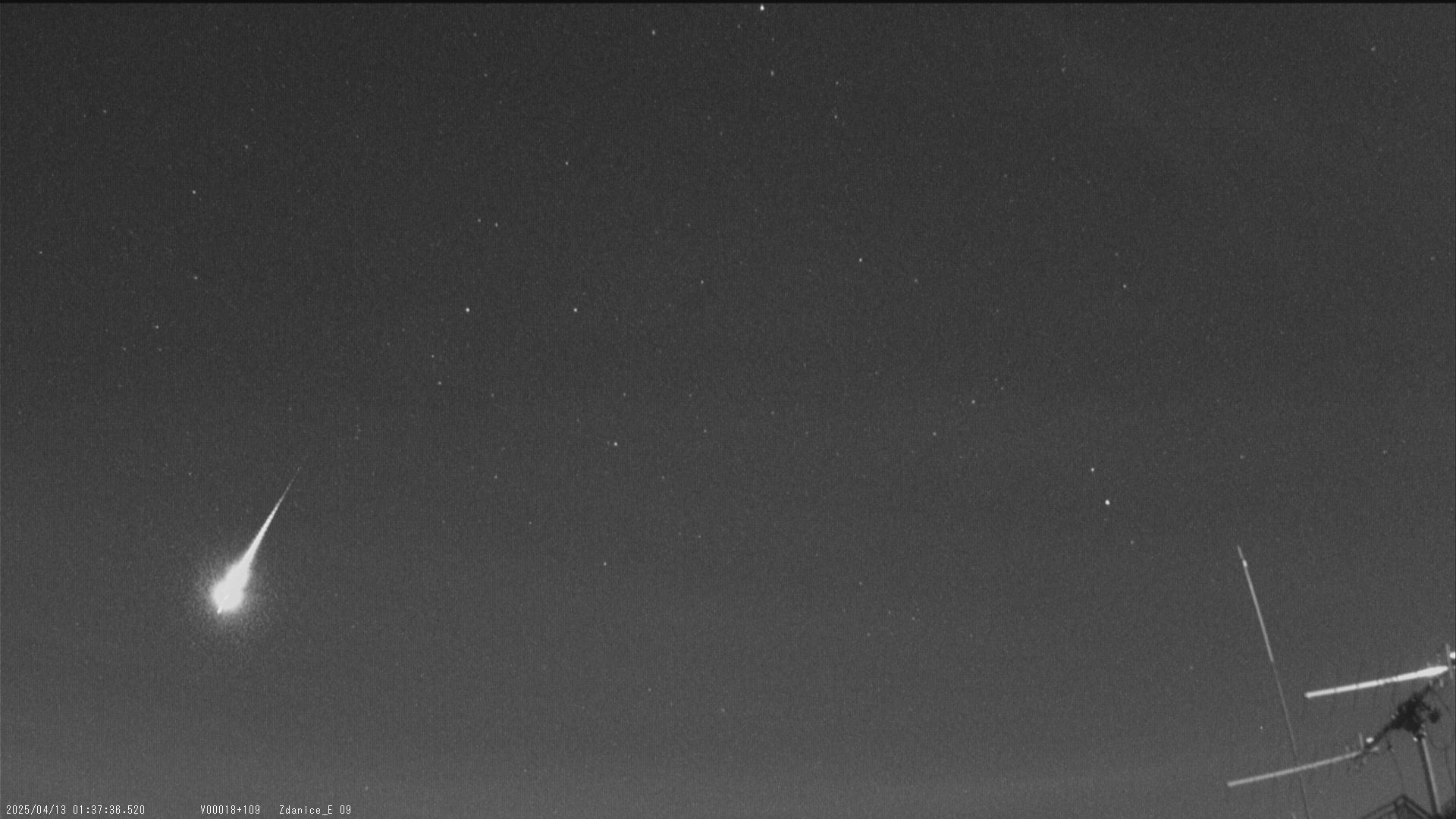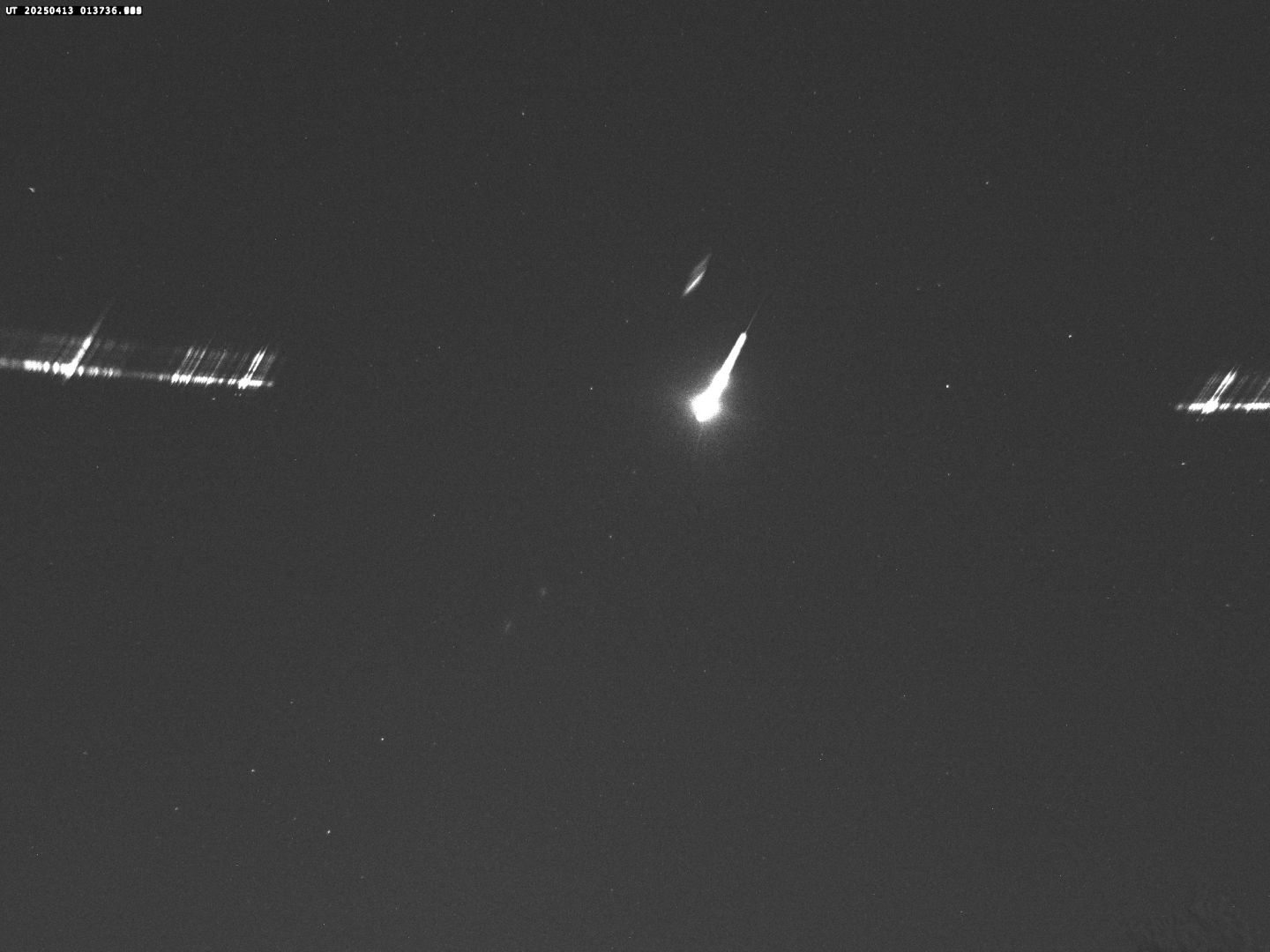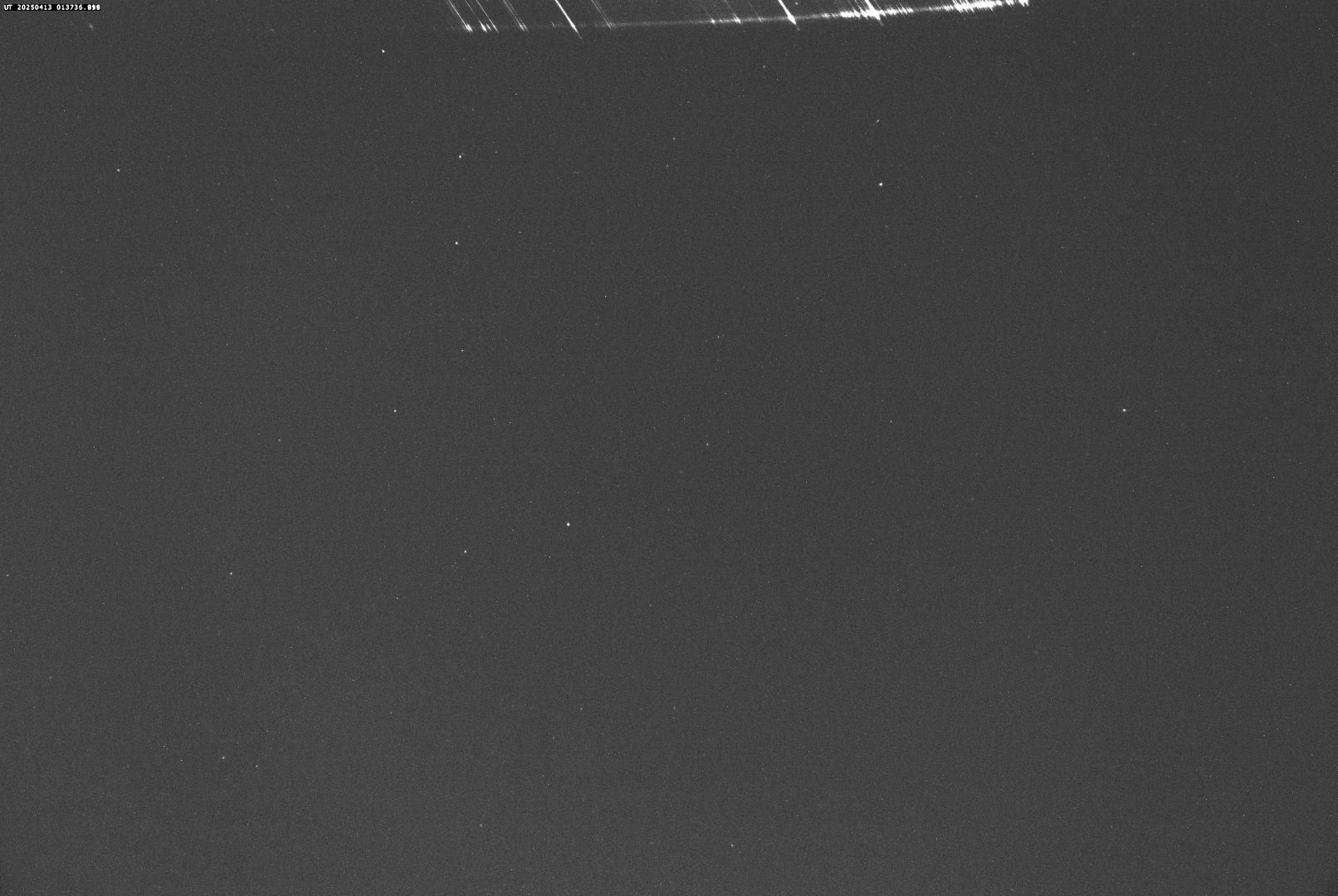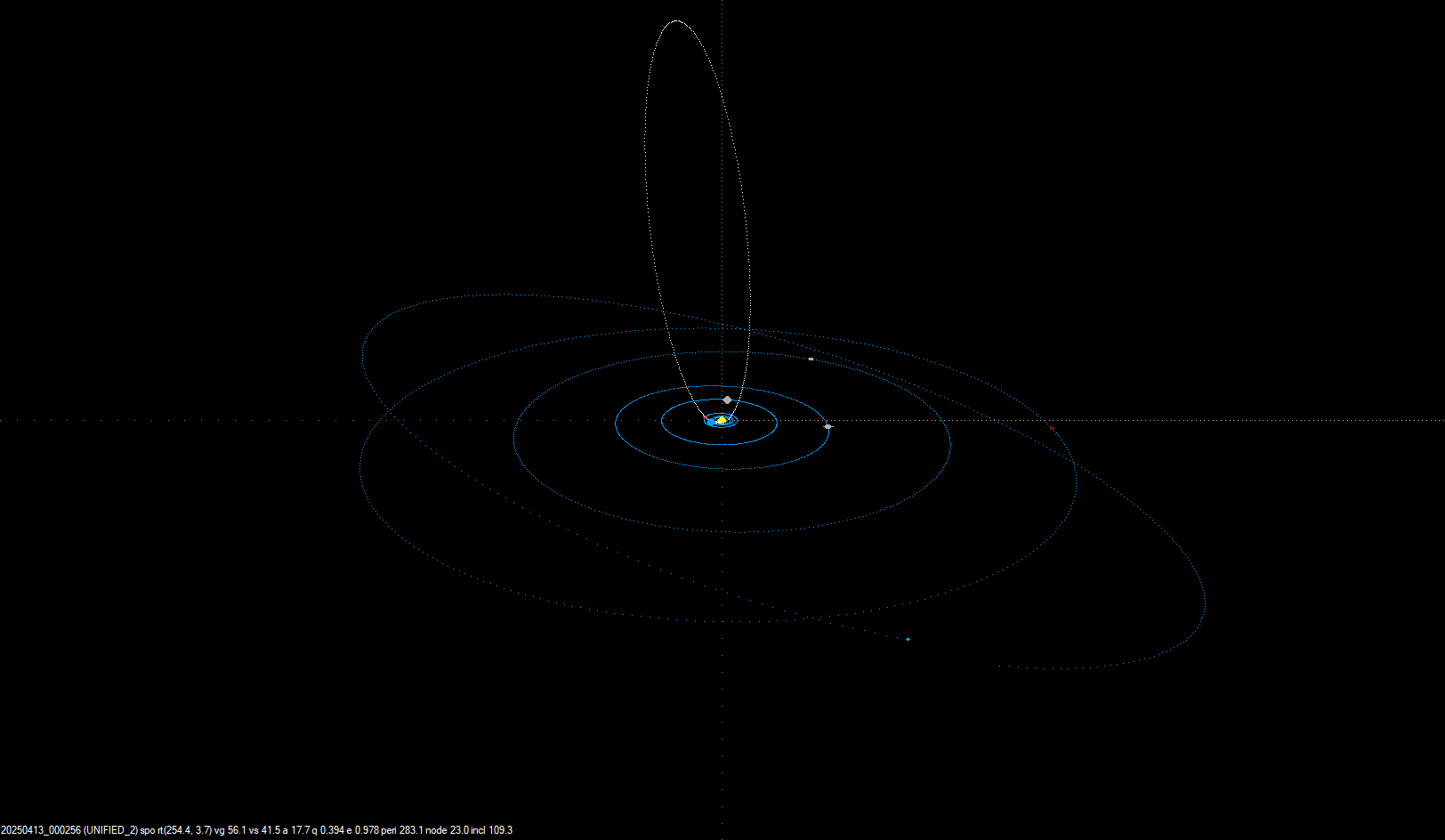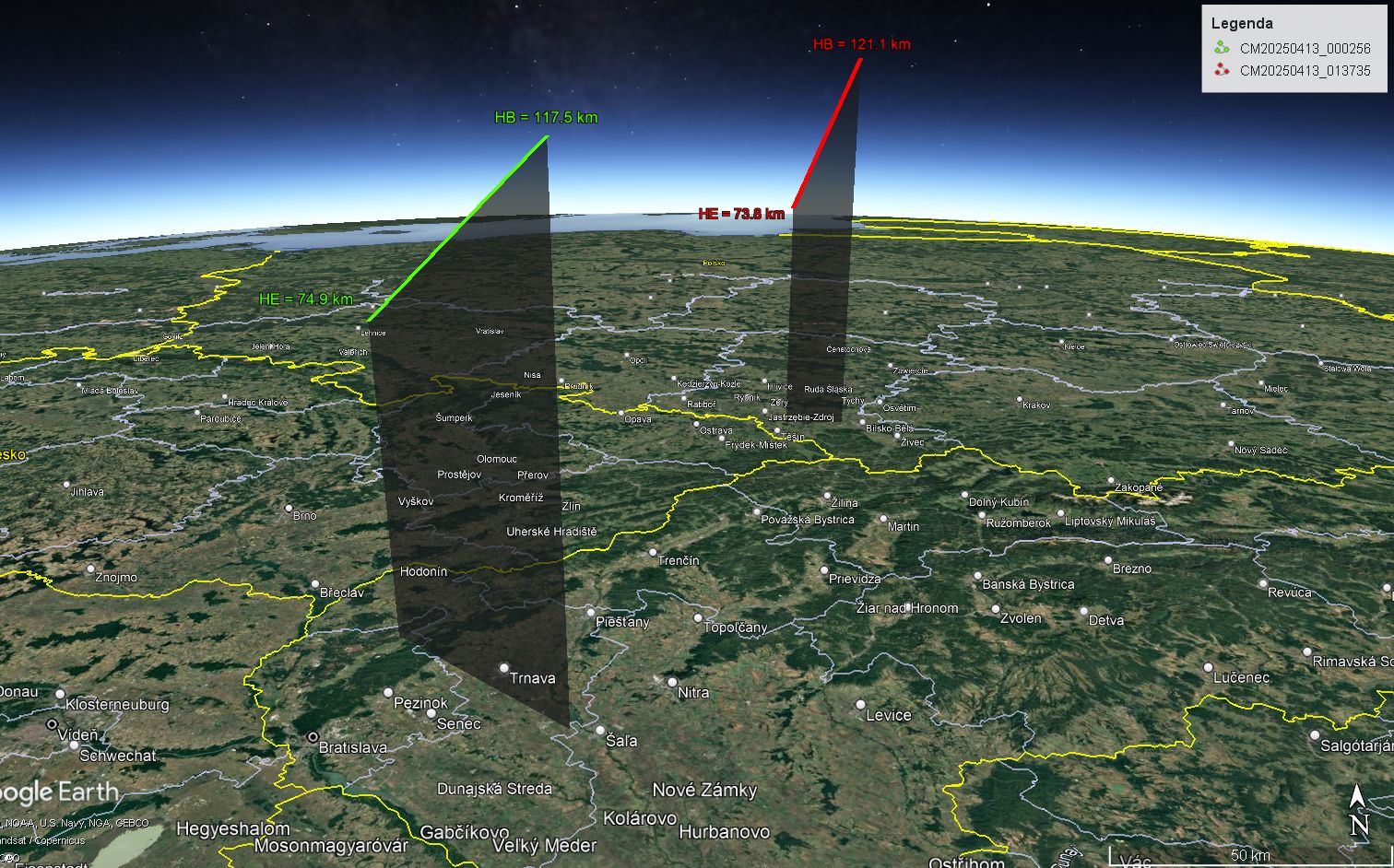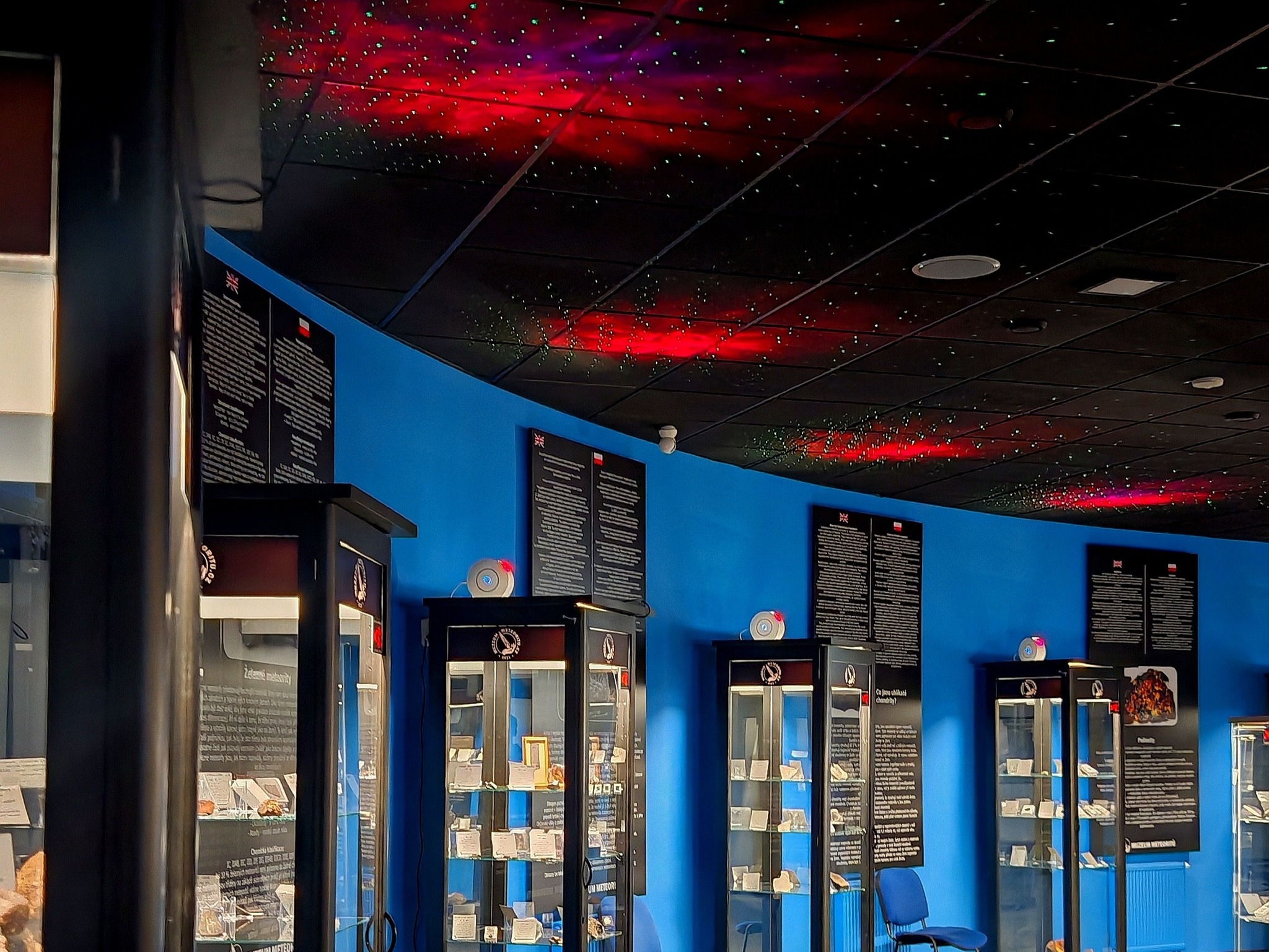Two Bright Fireballs in Early Morning of April 13, 2025
Despite relatively high meteoric activity, the first quarter of this year was poor in bright meteors. In the months of February and March, almost 10,000 single-station meteors were recorded at Central European Meteor Network (CEMeNt) stations, yet interesting meteors were recorded rather exceptionally. This pattern was broken only by the night of April 12/13, 2025, when two bright fireballs were recorded in the late night hours less than two hours apart. These were not meteors with a common parent body, though both were of cometary origin and their atmospheric ablation path ended at heights above 70 km.
Fireball CM20250413_000256 lit up the sky over southwestern Slovakia on April 13, 2025 at 00h02m56.3 ± 0.1s UT, shortly after two o'clock in the morning Central European Summer Time (CEST). Within the CEMeNt network, the fireball was recorded directly on three wide-angle cameras (Fig. 1-3). The fireball's flight was recorded from stations Valašské Meziříčí SE (CZ, Valašské Meziříčí Observatory), Maruška SW (CZ, Jakub Koukal) and Štípa S (CZ, Richard Káčerek). In addition to these stations, the spectrum of the fireball's passage was recorded by a spectrograph at Valašské Meziříčí Observatory (spectrograph VM_SPSE), which is crucial for determining the body's chemical properties (Fig. 10).
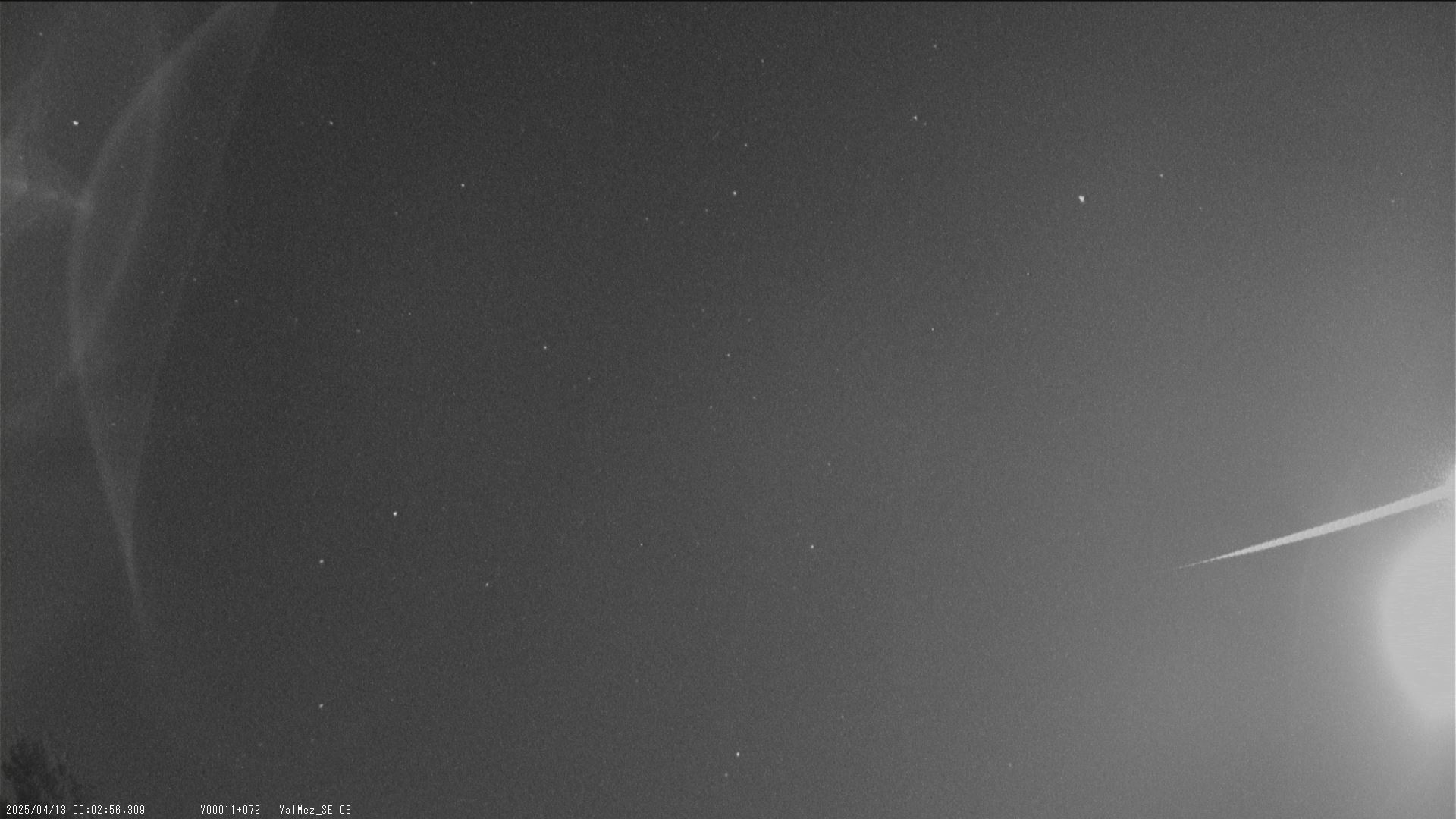
Fig. 1: Composite image of fireball CM20250413_000256, captured by the Valašské Meziříčí SE camera. Author: Valašské Meziříčí Observatory
Fireball CM20250413_013735 lit up the sky over southern Poland on April 13, 2025 at 01h37m35.9 ± 0.1s UT, before four o'clock in the morning CEST. Within the CEMeNt network, the fireball was recorded directly on seven wide-angle cameras (Fig. 4-9). The fireball's flight was recorded from stations Valašské Meziříčí NE (CZ, Valašské Meziříčí Observatory), Pardubice SE and NE (CZ, Pardubice Observatory), Vsetín E (CZ, Vsetín Observatory), Ždánice E (CZ, Ždánice Observatory), Jablonec N (SK, Jakub Kapuš) and Partizánske NE (SK, Partizánske Observatory). In addition to these stations, the spectrum of the fireball's passage was recorded by spectrographs at Valašské Meziříčí Observatory (spectrographs VM_SPNE and VM_SPNW), which is crucial for determining the body's chemical properties (Fig. 11 and 12).

Fig. 7: Composite image of fireball CM20250413_013735, captured by the Vsetín E camera. Author: Vsetín Observatory
Atmospheric Path, Radiant and Heliocentric Orbit of the Fireball
For the calculation of fireball CM20250413_000256's atmospheric path and the meteoroid's orbit in the Solar System, all recordings were used, with only the initial parts of all recordings used for calculating the meteoroid's orbit in the Solar System. This approach reduces the deceleration factor that must be corrected for in the observed entry velocity—bodies are not decelerated as intensively in the upper atmospheric layers as in lower ones. Recordings from these stations were made using UFO Capture HD software, processing was done in UFO Analyzer v4.32, and atmospheric and heliocentric orbit calculations in UFO Orbit v2.63.
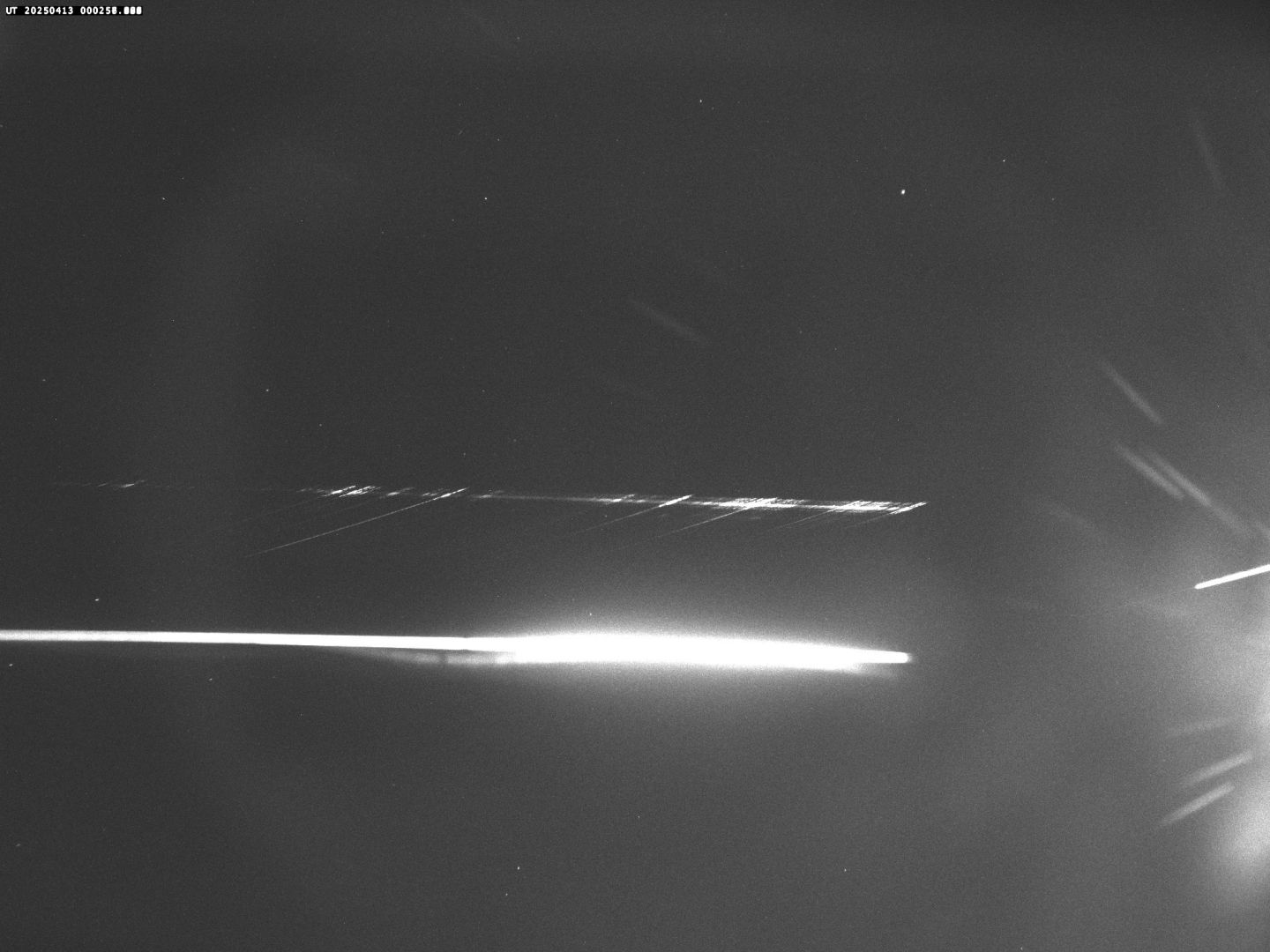
Fig. 10: Composite image of fireball CM20250413_000256 spectrum from the VM SPSE spectrograph. Author: Valašské Meziříčí Observatory
The initial height of the meteor's ablation path was 117.5 km above Earth's surface, with the body entering Earth's atmosphere at a speed of 57.39 km/s. The end of the meteor's ablation path was at a height of 74.9 km (Fig. 15), the fireball reached an absolute magnitude of -7.1 m and during its 1.5 s flight traveled a distance of 72.0 km through Earth's atmosphere. The body with an initial mass of 49 g entered Earth's atmosphere at a relatively low angle of 35.6°; it was a fast fireball with a geocentric velocity of 56.11 km/s. The body belonged to sporadic meteors and before entering the atmosphere moved along an elongated retrograde orbit (Fig. 13) with high eccentricity e = 0.978, high inclination to the ecliptic plane i = 109.34° and perihelion q = 0.3944 AU. The body was of cometary origin with an unknown parent body. To initially determine the parameters of the meteoroid's heliocentric orbit, the Tisserand parameter relative to Jupiter was calculated. Depending on the Tisserand parameter value, orbital inclination, and aphelion distance, bodies can be divided into 4 groups. According to this classification, fireball CM20250413_000256 belongs to the HT (LPC) group, i.e., the group of meteoroids with cometary origin and long-period parent body (1P/Halley comet group).
For the calculation of fireball CM20250413_013735's atmospheric path and the meteoroid's orbit in the Solar System, all recordings were used except for the Partizánske NE station, with only the initial parts of these recordings used for calculating the meteoroid's orbit in the Solar System. The initial height of the meteor's ablation path was 121.1 km above Earth's surface, with the body entering Earth's atmosphere at a speed of 42.75 km/s. The end of the meteor's ablation path was at a height of 73.8 km (Fig. 15), the fireball reached an absolute magnitude of -6.4 m and during its 1.4 s flight traveled a distance of 51.1 km through Earth's atmosphere. The body with an initial mass of 43 g entered Earth's atmosphere at a high angle of 67.0°; it was a medium-fast fireball with a geocentric velocity of 41.14 km/s. The body belonged to the R-Lyrid meteor shower (IAU MDC 0653 RLY) and before entering the atmosphere moved along an elongated prograde orbit (Fig. 14) with high eccentricity e = 0.858, high inclination to the ecliptic plane i = 69.66° and perihelion q = 0.9986 AU.
The body was of cometary origin with an unknown parent body. To initially determine the parameters of the meteoroid's heliocentric orbit, the Tisserand parameter relative to Jupiter was calculated. Depending on the Tisserand parameter value, orbital inclination, and aphelion distance, bodies can be divided into 4 groups. According to this classification, fireball CM20250413_013735 belongs to the HT (LPC) group, i.e., the group of meteoroids with cometary origin and long-period parent body (1P/Halley comet group).
Acknowledgments
Acknowledgments go to DEZA , Inc. and CS CABOT , Ltd., which contributed to the acquisition of equipment for FHD stations located at Valašské Meziříčí Observatory and within the CEMeNt network. Thanks also go to all partner observatories (Ždánice, Vsetín, Rokycany, Plzeň, Karlovy Vary, Partizánske, Kysucké Nové Mesto) and private station owners (Milan Čermák, Richard Kačerek, Jakub Kapuš, Tibor Csorgei, Vladimír Bahýl) for supporting the network's activities and growth. Further thanks to all interested institutions for supporting the network's activities and growth. The RPOS project (Development of Cross-border Observation Network) was co-financed from the Small Projects Fund of the Interreg V-A Slovakia – Czech Republic 2014 – 2020 program, call code 5/FMP/11b, reg. no. CZ/FMP/11b/05/058. The KOSOAP projects (Cooperating Network in the Field of Astronomical Professional Observation Programs) and RPKS (Development of Cross-border Cooperating Network for Professional Work and Education) were implemented by observatories Valašské Meziříčí (CZ) and Kysucké Nové Mesto (SK) in cooperation with SMPH (Society for Interplanetary Matter). Projects were co-financed from the Microprojects Fund of the Cross-border Cooperation Operational Program Slovakia – Czech Republic 2007-2013. The project for purchasing and operating high-resolution spectroscopic cameras is partially subsidized by the Regional Cooperation Program of the Czech Academy of Sciences, reg. no. R200402101.

